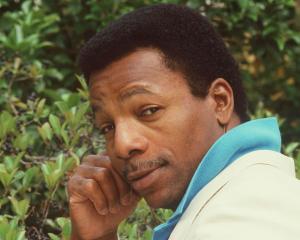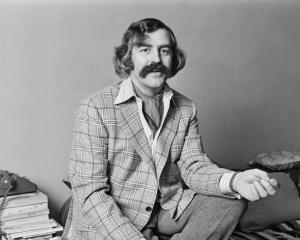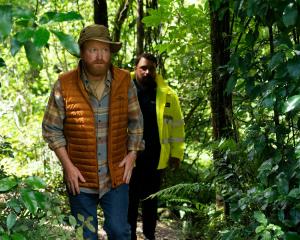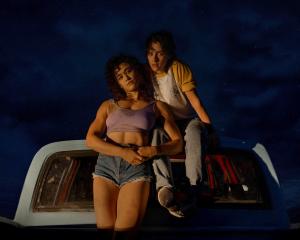
It's the first dystopian parable that's actually ecstatic fun.
It's also the closest Pixar has come to making a full-length silent movie.
The choice of hero is audacious: a beeping, whirring Waste Allocation Load Lifter, Earth-class, or Wall-E.
For long, unbroken, startlingly seductive stretches, we see him navigate an abandoned American city all by himself. (He does have a pet cockroach.)
Thanks to him, towering ziggurats made of trash compacted into cubes have sprouted up among malls and skyscrapers.
Wall-E director Andrew Stanton says he didn't let the silence of these sections stymie him.
To Stanton, Wall-E is not a silent movie that just happens to have sound; it's a regular movie that just happens to use unconventional dialogue.
"My methodology, from the script on, was no different than it was approaching any 'regular' movie. It's like I was dealing with a hero who spoke French all the time."
Squat and scrappy, with binocular-like eyes that are as warm and eloquent as Bambi's, Wall-E looks like a cross between R2-D2 and a Cubist portrait of a geek.
He's the sole and surprisingly spirited survivor of a mammoth clean-up operation.
After Earth grew clogged with trash, the all-consuming Buy n Large corporation sent the human population into outer space and left behind a mechanical janitorial super-service to make the globe habitable once again.
But these plans went awry and the one trash-compactor left is Wall-E, who has developed curiosity, survival skills and surprising wells of emotion, and expresses them with little more than a crook of his articulated elbows or a shift of his bifurcated head.
Stanton's love for silent movies gave him confidence.
"You just want to make sure the visuals and the acting carry as much information as possible because people's senses are going to be a little more focused on them without dialogue."
Stanton wrote the script with Jim Reardon, an old friend and college classmate who directed 35 episodes of The Simpsons.
"We put dialogue in brackets: We knew we would be swapping it out with something else to convey it . . . so I wrote what I expected them to `say'."
The influence of silent films on Pixar has been pronounced from the beginning.
When I interviewed Stanton 13 years ago at Pixar's old Point Richmond headquarters in the San Francisco Bay Area (the company has since moved to nearby Emeryville, California), he told me, "Buster Keaton is God."
Despite Stanton's devotion to Keaton, Charlie Chaplin's Tramp may be the silent clown who hovers over the plucky and poignant Wall-E.
Stanton agrees that in addition to "hundreds of other films", Wall-E has a touch of Chaplin's Modern Times: in content, as "an indirect comment on one possibility of the automation of humanity and losing your soul".
And in style, too - Modern Times (1936) was a silent made in the sound era, with a music track, sound effects, gibberish and only a smattering of English.
And just as Modern Times, despite its mordant view of modern industry, became Chaplin's cheeriest film because of the Tramp's romance with "a gamin" (Paulette Goddard), Wall-E is Pixar's most piquant and satisfying film because of Wall-E's courtship of Eve, the svelte Extraterrestrial Vegetation Evaluator sent from the Buy n Large mother ship to see if plants have started growing again on Earth.
Eve helped Stanton locate the core of the movie and also simply added to the pantomimed fun: "I already had one `person' who spoke a different language than I did, and now he'd fall in love with someone of a different nationality who spoke another language."
The influences he drew on went way beyond silent films.
"I'm more of a moviegoer than a moviemaker," Stanton said.
"I don't want to see the same thing twice."
He must be one heck of a moviegoer, because, as a director, no-one has a track record stronger than Stanton's.
Not only has he been a member of John Lasseter's team since Pixar's creative mastermind began assembling his animation brain trust (Stanton shares screenplay and story credit on Lasseter's debut feature, Toy Story), he also co-directed A Bug's Life with Lasseter and directed Finding Nemo solo.
Still, you see what he means.
After his first two pictures, Stanton was poised to become a modern-day Aesop on an epic scale, hatching fables about the seductiveness and perils of domesticity and adventure that use the virtual reality of computers to open up whole natural worlds.
Instead, with Wall-E, he drew on different models, such as Alien.
"Usually, in a script, there's a regular-looking paragraph of description and then there's dialogue at the centre of the page.
What the Alien script did was break the description down into little five-to-eight-word phrases, and then put four or five of those phrases in a row . . . and it looked like a haiku."
It "created a rhythm for the reader that made each of these little, quiet, completely visual moments major things to focus on. It actually put you in the pacing that you feel while you're watching.
"And I was so inspired by that! On the page, it made description just as important - if not more important - than the dialogue".
Pixar has always ignored the Disney-cartoon tradition of treating every cartoon feature as a Broadway musical comedy.
Paradoxically - and hilariously, and touchingly - this mostly silent sci-fi movie makes a musical comedy central to its story.
Wall-E, having found a VHS tape of Hello Dolly! has grown addicted to the buoyant tune, Put On Your Sunday Clothes (When You Feel Down and Out).
"I knew when I thought of it, that it was the weirdest idea I ever had in my life," Stanton said.
"It was literally one of those things that just came over me, and I couldn't explain it. I knew it was so crazy it just might work - I knew it could go out there in the beginning over these images of stars."
It took him a while to realise that it clicked in his head because "The song itself was about two naive guys who want to go out in the big town for a night and kiss a girl. That's my main character!"












